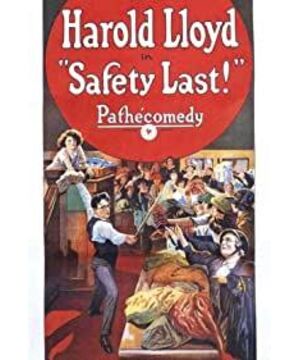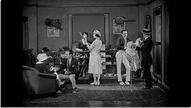The progress of the trend of the times will always leave the purest accumulation in the agitation. This kind of time-honored accumulation, such as love, will be talked about even after ten, a hundred, or a thousand years, right? Just like the scene shown to us by the animated movie "WALL.E", the robot Walli in 2805 will also be starred in the love song and dance film "Hello, Dolly!" starring Barbra Streisand. "(HELLO, DOLLY!) moved. Love will last forever as one of the elements of the development of human civilization.
Since the birth of the movie in 1895, countless movies about love have been shown on the screen time and time again, interpreting a proposition from different angles: what is love.
what is love? I love you, just like sickness and prescription; in "Love in Trilogy", love is the long flow of helplessness and the chatter of you and me; in "Song in the Rain", love is danced by Jin Kelly in the pouring rain Rejoicing; and in "SAFETY LAST" starring Harold Lloyd, love is the bravery and meaninglessness of daring to do anything for each other.
"Safety First", a black-and-white romantic comedy silent film shot in the 1920s, belongs to the same era as the silent film starring Charlie Chaplin and Buster Keaton, and has a somewhat "yuliang" meaning. However, the three comedy silent actors have their own characteristics: in the same silent theme about love, Chaplin’s usual routine is dedication: in his most prestigious "City Lights", Charlie the tramp He used his selfless love and dedication to help the blind flower girl regain the light; Buster Keaton, the "smiley star", is good at facing everything with his seemingly cold face; and here comes Ha Here is Rod Lloyd. In the movie "Safety First", Lloyd, who plays the role of a clerk, adopts the dual principles of courage and adventure to capture the love of his lover... All roads lead to Rome, and he is heading for love. On the road, the three individuals displayed their best housekeeping skills, and finally got their due rewards.
Back to the film "Safety First". How much effort can you put in for your lover?
I can’t eat enough to give my loved one a necklace; I
’m struggling to travel in the busy traffic just not to lose my job; I
’m climbing a tall building with my bare hands in order to get a $1,000 bonus to marry my lover...
All of this comes from the role played by Lloyd. This is not a perfect character, and the adventurous staff in the film also has many shortcomings. In other words, the adventures he has experienced in the film are completely self-bound. He loves her so much that he wants to create the best life for her with his own efforts. He is obviously just a teller in a department store but he wants to tell his lover that he has an important job in a department store.
In the cruel reality, in order to fulfill his promises and make up for the white lies he had told his lover before, he had to use more adventurous behaviors to "care" the "beautiful lies" he created. This kind of risky behavior first pretended to be a department store manager, but in the end it evolved into a reckless behavior of climbing tall buildings with bare hands in order to get a 1,000-dollar bonus. Of course, this is a comedy romantic silent film after all, and it is inevitable that there will be exaggerations in the plot. When we get rid of these overstatements and examine the love-related things in the movie, we will find that the love story told in this 1920s movie is simple and beautiful.
The understanding of love between East and West is so different. In the oriental view of love, liking someone is the entanglement of "can't ask for it, tossing and turning" and the hesitation of "speaking yet ashamed", and it is also all the stories about perseverance and the interdependence of life and death like "Blessings of Love"; while in the West In people's concept of love, liking a person is to fight against a rival in fencing for the one you love. It is also a whisper to your lover again and again every day. Just like the plot presented to the audience in "Safety First", for the sake of the beloved, the small staff dare to deceive their boss and dare to climb tall buildings with their bare hands to earn bonuses. There is no difference between these two views of love, because although the East and the West have different forms of expressing love, they are essentially shouting "the name of love."
In addition to the plot, this black and white film shot in the 1920s also has many clever photography skills in filming. These techniques may be in the ordinary film expression methods today, and when we turn the time back a hundred years and answer the early days of the film’s birth, we cannot help but admire the great directors of the time in terms of film expression. s hard work. For example, in order to show the height of the department store that the staff climbed by bare hands in "Safety Down", the vertical overhead lens was used to highlight the difficulties of the staff climbing the stairs at the time; another example is to take a small shot on the ground like an ant moving insignificant. The characters also realize the director's intention to convey to the audience through this intuitive comparison rule.
In the great age, the love life of common people is always full of helplessness, but in the helplessness, it will inspire the most sincere actions of those who love each other. Such a move may seem dangerous, but it is a promise full of love. In the 21st century, there will always be people who complain that the feelings between people are becoming more and more indifferent, and the so-called love has become less simple than the previous "pure love age". And I always think, whenever we are discouraged because of social injustices, when we have witnessed a tragedy of love separation and we never dare to talk about love upright, we might as well think about this. In "Safety First", think about the little clerk who was fearful and unwilling to climb the department store with his bare hands. Think about this person who is always optimistic in the big era, and also be a brave and optimistic person.
Finally, we still have to believe in love.
(Attach a personal favorite poem, which is a small easter egg after film reviews)
============================== =======================================
Believe in the telescope-Cesar Vallejo (Peru )
Believe in the telescope, not the eyes;
believe in the stairs, but never believe in the steps;
believe in the wings, believe in the birds
and believe in you, believe in you, only believe in you.
Believe in malice, do not believe in evil people;
believe in wine glasses, but never believe in soju;
believe in corpses, do not believe in people
but also believe in you, believe in you, only believe in you.
Believe in many people, but no longer believe that a person
believes in the riverbed, but never believes in the river;
believes in the pants, does not believe in the legs,
but also believes in you, believes in you, only believes in you.
Believe in the window, not the door;
believe in the mother, but do not believe in nine months;
believe in fate, do not believe in the golden dice,
but also believe in you, believe in you, only believe in you.
View more about Safety Last! reviews






